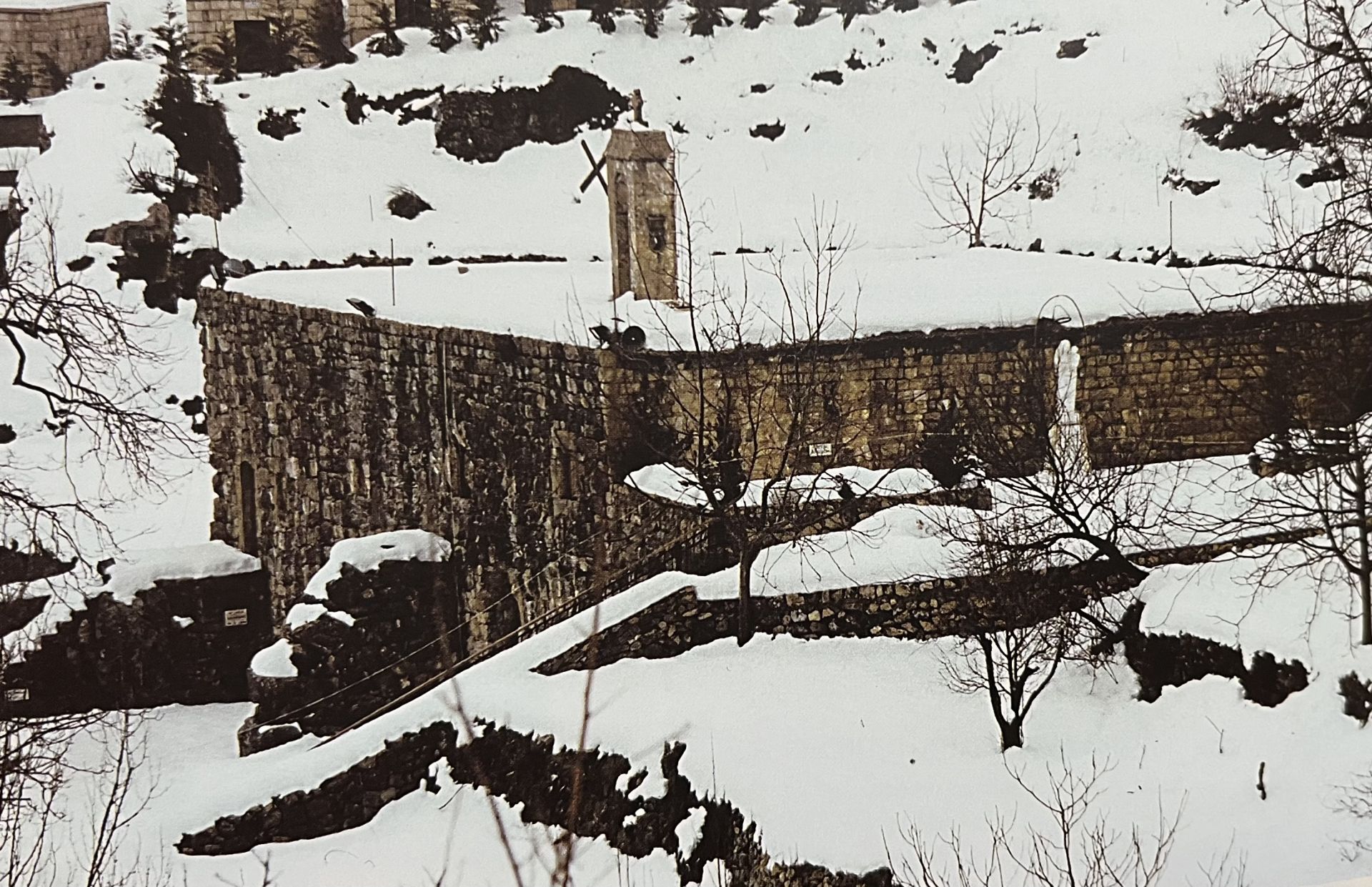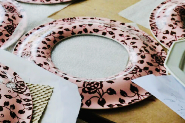
In addition to the iconographic painting that bears its name and its valuable citations in the Codex Rabulensis, Our Lady of Ilige houses two Syriac inscriptions carved in stone. Among them is a singular treasure for the Maronite tradition, for no other medieval Maronite inscription is known to have survived the devastation of the Mamluk era. This epigraph allows us to glimpse the form of medieval Maronite script, recognized as the square Estrangelo.
Following Saint John Maron of Kfar-Hay (685–770) and Saint George of Yanouh (770–1120), Patriarch Peter I established his seat at Our Lady of Ilige in 1121. Ilige lies in a valley of the Mayfouq region, high above Byblos, annually cloaked in a thick mantle of snow. The monastery of Our Lady was built upon the remains of a Phoenician temple, nestled between two streams.
The Monastery of Ilige
The masonry is characteristic of the early Maronite Middle Ages. It draws indiscriminately on Canaanite megaliths, fragments of pagan sculpture, raw rock, and carefully squared stone. The overall effect seems to grow with the unpredictability of a living plant. A bull’s head emerges from a pedestal wedged to the right within the entrance vault. Bearing witness to its activity during the Byzantine period, a cross inscribed within a circle adorns the megalithic lintel of the main doorway.
Inside, the three naves rise at different levels. From the right-hand nave, a staircase leads up to the patriarchs’ quarters. From there, a small chamber hidden within the thickness of the wall can be reached. It once served as a secret refuge during Mamluk raids.
In the apse, a painting of the Virgin and Child holds a central place. For a long time, it was dated to the eighteenth century, until a restoration in the 1980s revealed successive layers reaching back to the tenth century.

This patriarchal monastery flourished during the Crusader period, exerting considerable influence over the County of Tripoli. At that time, the surrounding mountains were dotted with churches adorned with frescoes reflecting both Syro-Byzantine and Crusader styles, complemented by Syriac inscriptions. Ilige stood at the crossroads of three worlds: Byzantine, Latin, and Syro-Maronite, each with its own arts, schools, and languages.
The Patriarchs of Ilige
The patriarchs of Ilige are known for leaving their handwriting on the pages of the Codex Rabulensis. Among them, Jeremiah III of Dmalça (1282–1297), ally and protector of Bohemond VII, Count of Tripoli, is the author of the Syriac text in Estrangelo script on folio 6 v°.
He recounts how, in the year 1590 of the Greeks (1279 CE), he came to the monastery of Our Lady of Saint Mary of Mayfouq, in the valley of Ilige, in the land of Botroun, to Mor Pétros, Patriarch of the Maronites, in order to be ordained metropolitan of the monastery of Kaphtoun. He then wrote how, four years later, Bohemond VII, together with the bishops, archpriests, and hieromonks, had him elected patriarch and sent him to Rome.
The Syriac text on folio 8 r• is the work of Patriarch John IV of Gége. His account tells how, in the year 1550 of the Greeks (1239 CE), he received at the blessed monastery of Our Lady of Mayfouq the hieromonk Matthew from the Maronite monastery of Koutsovendis in Cyprus.
Ilige and Cyprus
Patriarch Peter III also mentions this Maronite monastery in Cyprus on folio 7 v°. He recounts how, in 1465 of the Greeks (1154 CE), he received at the convent of Our Lady of Mayfouq in the valley of Ilige the young monk Isaiah from the monastery of Qozhaya and ordained him superior of the convent of Saint John of Koutsovendis.
The monastery is also mentioned by Patriarch Estephanos Doueihi, who copied a note from the manuscript of the Homilies of Jacob of Sarugh. It originated from the scribe Simeon, who recorded that in 1432 of the Greeks (1121 CE), Patriarch Peter I, residing at the holy monastery of Mayfouq in the valley of Ilige, in the land of Botroun, had granted him the authority to preside over the monastery of Saint John of Kûzvandû (Koutsovendis)
This period of wealth and openness toward Cyprus and Europe came to a sudden end at the close of the thirteenth century with the departure of the Franks and the Mamluk invasion, which unleashed a genocide lasting over a century and only ending with the arrival of the Ottomans in 1516. The violence had become so severe that in 1440, Patriarch John VIII of Gége was forced to transfer the patriarchal seat to the monastery of Our Lady of Qannoubine in the Qadisha Valley.
This era of affluence and openness toward Cyprus and Europe came to a sudden end at the close of the thirteenth century with the departure of the Franks and the Mamluk invasion, which unleashed a genocide lasting more than a century and only ended with the arrival of the Ottomans in 1516. The violence had become so severe that in 1440, Patriarch John VIII of Gége was forced to transfer the patriarchal seat to the monastery of Our Lady of Qannoubine in the Qadisha Valley.
The 1276 Epigraph
In addition to the iconographic painting that bears its name and its valuable citations in the Codex Rabulensis, Our Lady of Ilige houses two Syriac inscriptions carved in stone.
The first one, on the main façade, is a unique treasure for the Maronite tradition, as it remains the only Maronite inscription from the medieval period that has not been moved and has survived the Mamluk devastation. This inscription allows us to identify the Maronite stone-carved script, known as square Estrangelo. It is incised using the Latin technique, rather than carved in relief as in Eastern inscriptions.
Its design is strongly geometric, likely influenced by monumental Latin script. The lettering is vertical, following the style of Syriac frescoes and the captions of the miniatures in the Codex of Rabula. The central cross is accompanied by Psalm 44:6 of King David: Through you we defeat our enemies, and by your name we trample those who rise against us.

This psalm is embedded within the text, which reads:
In the name of God, living forever,
In the year one thousand five hundred eighty eight of the Greeks (1276–1277),
Was completed
The construction (renovation) of this convent of the Mother of God, Mary.
May her prayer be with us. Amen.
By the hands of sinful men,
David and D… and Peter and John.
The 1746 Epigraph
The second epigraph is located on the side façade overlooking the torrent. It dates to the eighteenth century, a period that witnessed a revival of Syriac architecture and inscriptions thanks to the more tolerant rule of the Ottomans. After the Middle Ages, however, the dominant script became Serto, the cursive form that replaced monumental lettering. Thus, Frankish influence gradually gave way to the Arabic script traditions of the Turks and Arabs. Meanwhile, the inauguration of the Maronite College in Rome in 1584 brought an end to the use of the Antiochene era by the Syriac-Maronite Church, which from that point forward adopted the Gregorian calendar.

The side epigraph refers to a second restoration of the building. It reads, again in the Syriac language:
In the name of Yeh, the Ever-Living,
In the Christian year 1746, this sanctuary was restored
By the hands of two cleric brothers, Amon and Mikhael.
It had been governed by the four patriarchs Peter, Jeremiah,
And Jacob and John, since the year 1121.



Comments